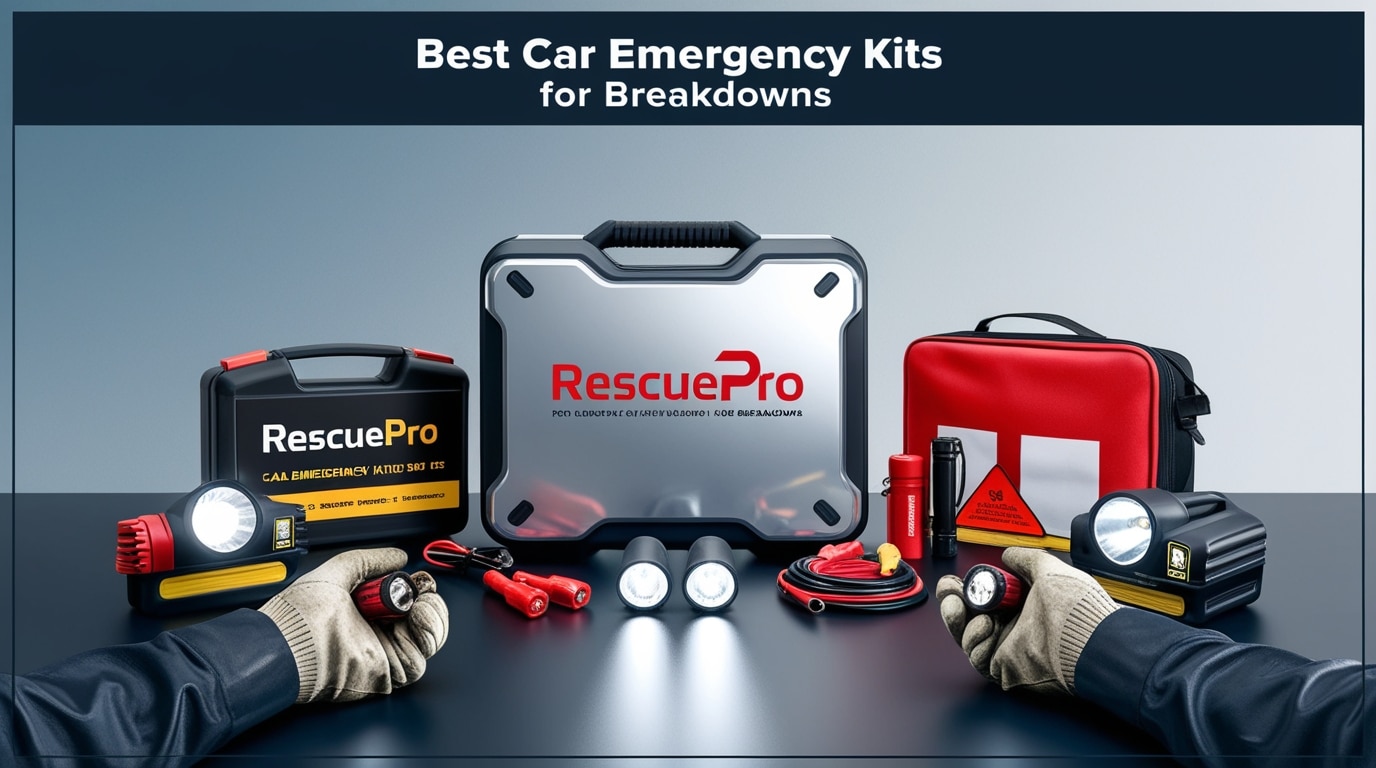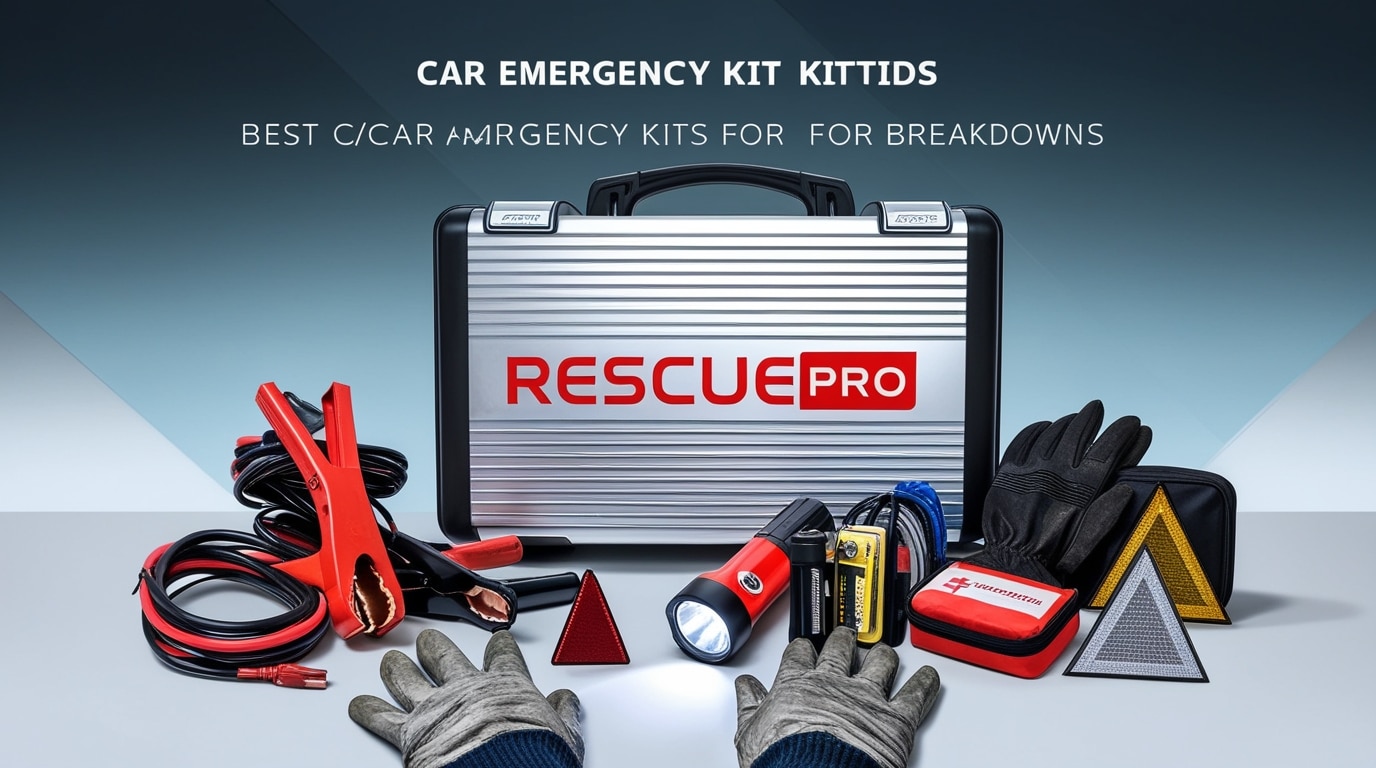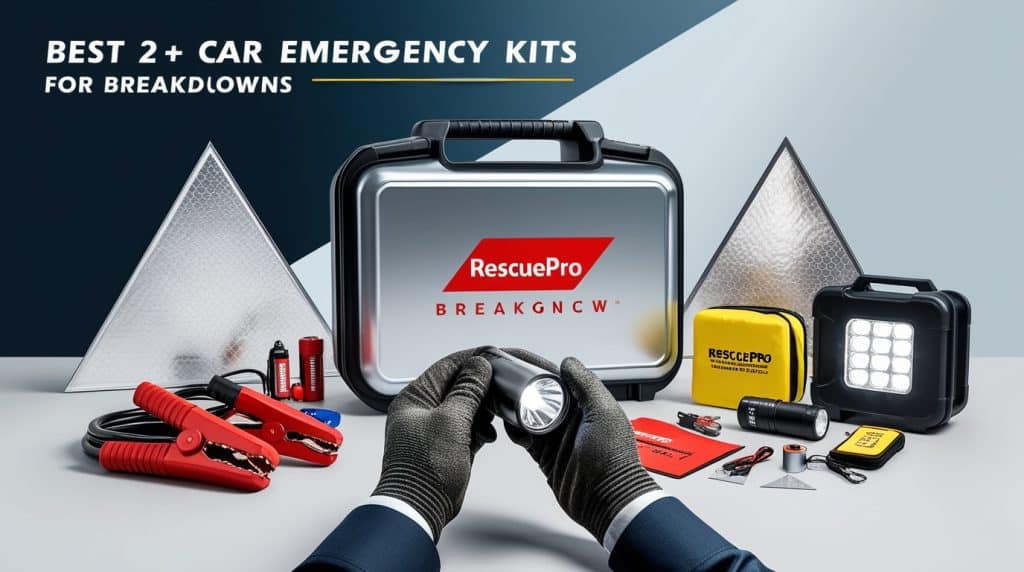Best Car Emergency Kits for Breakdowns: A Comprehensive Guide
Introduction
Breakdowns are an inevitable part of driving, whether due to mechanical failures, flat tires, or other unexpected issues. Being prepared with a well-stocked car emergency kit can turn a potentially stressful situation into a manageable one. In this guide, we’ll explore the best car emergency kits for breakdowns, providing you with insights into what makes a great kit, key features to look for, and some top recommendations for 2024.
1. Why You Need a Car Emergency Kit
A car emergency kit is not just a collection of tools and supplies; it’s your first line of defense against unexpected breakdowns and emergencies on the road. Here’s why every driver should have one:
- Immediate Response: Provides the tools and supplies needed to address common breakdown scenarios like flat tires, dead batteries, or minor injuries.
- Safety and Peace of Mind: Ensures you have the resources to stay safe, especially in remote areas or during harsh weather conditions.
- Time-Saving: Allows you to handle minor issues on the spot, reducing the time spent waiting for roadside assistance.
- Cost-Effective: A good emergency kit can save you money by enabling you to perform basic repairs or handle small emergencies without needing professional help.
2. Key Components of a Quality Car Emergency Kit
When choosing a car emergency kit, it’s essential to consider the components included. A comprehensive kit should cover various aspects of emergency preparedness. Here are the key components to look for:
a. Basic Repair Tools
- Jumper Cables: Essential for jump-starting a dead battery, jumper cables are a must-have in any car emergency kit.
- Tire Repair Kit: Includes tools like tire plugs, sealant, and an inflator to temporarily fix a flat tire.
- Multi-Tool: A versatile tool that includes pliers, screwdrivers, and a knife, useful for minor repairs and adjustments.
- Duct Tape: Can be used for temporary fixes, such as securing loose parts or patching leaks.
b. Safety and Visibility

- Reflective Warning Triangles: Helps alert other drivers to your presence, especially at night or in low visibility conditions.
- LED Flashlight: Provides light for working in the dark and can also serve as a signaling device.
- Reflective Safety Vest: Enhances your visibility if you need to leave your vehicle on a busy road.
c. Personal Safety and Comfort
- First Aid Kit: Should include bandages, antiseptic wipes, pain relievers, and other basic medical supplies.
- Thermal Blanket: Provides warmth in case you’re stranded in cold weather.
- Poncho: Protects you from rain if you need to work outside your vehicle in bad weather.
d. Additional Essential Items
- Portable Air Compressor: Allows you to inflate tires on the go, ensuring they’re at the correct pressure.
- Portable Jump Starter: A battery-powered device that lets you jump-start your car without needing another vehicle.
- Tow Strap: Useful for pulling your vehicle out of ditches or other tricky situations.
- Fire Extinguisher: A small, automotive-rated fire extinguisher can be crucial in case of engine fires or other fire-related emergencies.
3. Top Car Emergency Kits for 2024
With so many car emergency kits on the market, it can be challenging to choose the right one. Here are some of the best options available in 2024, each offering a unique set of features to suit different needs:
a. Lifeline AAA Excursion Road Kit
The Lifeline AAA Excursion Road Kit is an excellent choice for those looking for a comprehensive and reliable kit. This kit is designed in collaboration with AAA, a trusted name in roadside assistance.
- Key Features:
- Jumper Cables: Heavy-duty 8-gauge, 10-foot cables.
- Tire Repair Tools: Includes a tire pressure gauge, tire sealant, and tools for minor repairs.
- Safety Items: Reflective triangle, safety vest, LED flashlight, and whistle.
- Personal Comfort: First aid kit, blanket, and poncho.
- Why It’s Great: The Lifeline AAA Excursion Road Kit offers a well-rounded selection of tools and safety items, making it suitable for both urban and rural driving.
b. Gear Aid Vehicle Emergency Kit
The Gear Aid Vehicle Emergency Kit is known for its durable and high-quality components, making it a great option for those who frequently drive in challenging conditions.
- Key Features:
- Multi-Tool: High-quality multi-tool with 14 functions, including pliers, a knife, and screwdrivers.
- Tow Strap: 12,000-pound capacity, perfect for heavy vehicles.
- Portable Air Compressor: Compact and efficient, with a digital display.
- Jumper Cables: 10-foot, 6-gauge cables with durable clamps.
- Additional Safety: Includes a first aid kit, reflective vest, and flashlight.
- Why It’s Great: Gear Aid’s kit is built to last, with premium components designed for durability and reliability in tough environments.
c. Swiss Safe 2-in-1 Emergency Roadside Assistance Kit
The Swiss Safe 2-in-1 Emergency Roadside Assistance Kit is a great choice for drivers looking for a compact yet comprehensive solution. It combines essential emergency tools with a high-quality first aid kit.
- Key Features:
- Dual Compartments: One side dedicated to vehicle repair tools, the other to first aid supplies.
- Jumper Cables: 8-gauge, 12-foot cables with heavy-duty clamps.
- Safety Items: Reflective triangle, safety vest, and LED flashlight.
- First Aid Kit: Includes over 100 pieces, such as bandages, antiseptic wipes, and a CPR mask.
- Why It’s Great: The Swiss Safe kit’s 2-in-1 design makes it easy to organize and access both repair tools and medical supplies.
d. HAIPHAIK Emergency Roadside Toolkit
The HAIPHAIK Emergency Roadside Toolkit is an all-inclusive kit designed for serious drivers who want to be prepared for any situation. It’s especially popular among truck and SUV drivers.
- Key Features:
- Heavy-Duty Tow Strap: 16,000-pound capacity, ideal for larger vehicles.
- Jumper Cables: 12-foot, 8-gauge cables with copper clamps.
- Multi-Tool and Portable Compressor: High-quality multi-tool and a compact air compressor with digital gauge.
- Safety and Comfort: Reflective vest, LED flashlight, and a thermal blanket.
- Fire Extinguisher: Compact, easy to use, and designed for automotive fires.
- Why It’s Great: HAIPHAIK’s kit is perfect for drivers of larger vehicles, offering robust tools and safety equipment tailored for heavy-duty use.
e. Be Smart Get Prepared Auto Emergency Kit
The Be Smart Get Prepared Auto Emergency Kit is an affordable option that doesn’t skimp on essential items. It’s a great choice for budget-conscious drivers who still want to be prepared.
- Key Features:
- Jumper Cables: 10-foot, 8-gauge cables with robust clamps.
- Tire Repair and Air Compressor: Includes a tire repair kit and a compact air compressor.
- First Aid Kit: 66-piece first aid kit with all the basics.
- Safety Items: Reflective triangle, flashlight, and whistle.
- Why It’s Great: This kit offers excellent value for money, providing a wide range of essential tools and supplies at an affordable price.
4. Customizing Your Car Emergency Kit
While pre-packaged car emergency kits are convenient, customizing your kit can ensure it meets your specific needs. Here’s how you can tailor a kit to suit your driving habits and conditions:
a. Consider Your Vehicle Type
Different vehicles have different needs. For example:
- SUVs and Trucks: May require a heavier-duty tow strap, larger tire repair tools, and a more powerful jump starter.
- Compact Cars: Focus on space-saving tools and supplies, such as a compact air compressor and foldable warning triangles.
b. Account for Weather Conditions
The climate you drive in should influence what you include in your kit:
- Cold Climates: Add extra blankets, an ice scraper, and tire chains.
- Hot Climates: Include additional water, a sunshade, and a portable fan.
c. Frequency of Long-Distance Travel
If you frequently take long trips, especially through remote areas:
- Navigation Tools: Include a paper map in case GPS fails.
- Extra Food and Water: Store non-perishable snacks and plenty of water.
- Communication Devices: Consider a CB radio or satellite phone for areas with poor cell reception.
d. Family Considerations
If you travel with family members, especially children:
- Extra Supplies: Include items like baby wipes, extra snacks, and entertainment for kids.
- Larger First Aid Kit: Ensure your first aid kit is stocked with supplies for everyone in the vehicle.
5. Maintaining Your Car Emergency Kit
Having a car emergency kit is only helpful if it’s well-maintained. Regularly checking and updating your kit ensures everything is in good working order. Here’s how to maintain your kit:
a. Regular Inspections
- Check Expiration Dates: Items like batteries, first aid supplies, and food have expiration dates. Replace them as needed.
- Test Equipment: Periodically test items like flashlights, air compressors, and jump starters to ensure they’re functioning properly.
- Inspect Tools: Look for signs of wear or damage on tools, such as frayed jumper cables or a damaged multi-tool.
b. Seasonal Updates
- Winter: Add winter-specific items like an ice scraper, tire chains, and extra blankets.
- Summer: Include sun protection items like a sunshade and extra water.
c. Replenishing Used Items
If you use any items from your kit, make sure to replace them as soon as possible. This ensures your kit is always ready for the next emergency.
d. Storage Tips
- Location: Store your emergency kit in an easily accessible location in your car, such as the trunk or under a seat.
- Securing Items: Use a durable, waterproof bag or container to protect your kit from the elements and keep items organized.
6. Conclusion
A well-prepared car emergency kit is an essential part of responsible vehicle ownership. Whether you’re facing a flat tire, a dead battery, or an unexpected breakdown, having the right tools and supplies on hand can make all the difference. By investing in a high-quality emergency kit and customizing it to meet your specific needs, you’ll be ready to handle any situation with confidence.
Remember, the best car emergency kit is one that you’ve carefully chosen, stocked, and maintained. Take the time to review your kit regularly, update it with seasonal items, and ensure that it’s always in good working order. With the right preparation, you can hit the road knowing that you’re ready for whatever comes your way, making every journey safer and more enjoyable. Safe travels!
7. Factors to Consider When Choosing a Car Emergency Kit
Selecting the best car emergency kit for your needs involves more than just picking the most expensive or most comprehensive option. It’s important to consider several factors to ensure that the kit you choose will be useful and practical for your specific situation. Here are some key factors to keep in mind:
a. Kit Size and Portability
- Compactness: If space in your vehicle is limited, look for a kit that is compact and easy to store. Some kits are designed to fit neatly in the trunk or under a seat without taking up too much room.
- Weight: If you anticipate needing to carry the kit with you, such as when hiking away from your car in a breakdown scenario, the weight of the kit becomes important. A lighter kit with essential items may be preferable to a bulky, heavy one.
b. Comprehensiveness
- Essential Tools: Ensure the kit includes all the essential tools and supplies, such as jumper cables, a tire repair kit, a flashlight, and a first aid kit. These are the basics that every emergency kit should cover.
- Specialty Items: Depending on your specific needs, you may want a kit that includes specialty items, such as a portable air compressor, a fire extinguisher, or a multi-tool with a variety of functions.
c. Quality of Components
- Durability: The quality of the tools and materials in the kit is crucial. Look for kits that feature durable, heavy-duty tools, such as thick-gauge jumper cables, strong tow straps, and robust multi-tools. Cheap, flimsy tools are less likely to withstand the rigors of an actual emergency.
- Reputable Brands: Kits from reputable brands are often a safer bet as they are more likely to use high-quality components. Check reviews and ratings to gauge the reliability of a particular brand or kit.
d. Customization Options
- Modularity: Some kits allow for easy customization, letting you add or remove items based on your needs. This is particularly useful if you want to tailor a kit to specific conditions, such as off-road driving or long-distance travel.
- Personalization: Consider whether the kit has enough space or compartments to add your own items. You might want to include personal medications, extra food, or tools that are specific to your vehicle.
e. Price vs. Value
- Cost: While it might be tempting to go for the cheapest option, remember that you often get what you pay for. A slightly more expensive kit that offers better quality and more comprehensive coverage is usually a better investment.
- Value for Money: Consider the overall value of the kit. Does it offer a good balance of price, quality, and the number of included items? A kit with a higher initial cost might be more economical in the long run if it prevents the need for additional purchases.
f. Weather Resistance
- Waterproofing: If you live in an area with frequent rain or snow, a waterproof or water-resistant emergency kit is essential to keep your tools and supplies dry and functional.
- Temperature Tolerance: Ensure that the items in your kit can withstand extreme temperatures, especially if you live in areas with harsh winters or hot summers. Some items, like batteries or medical supplies, may need to be specifically designed to operate under these conditions.
g. Ease of Use
- Clear Instructions: The kit should come with clear, easy-to-understand instructions for using the tools and supplies. This is particularly important for more complex tools, such as a portable jump starter or tire repair kit.
- Accessibility: Tools and supplies should be easy to access quickly in an emergency. A well-organized kit with labeled compartments or a layout that allows you to grab what you need without digging through a pile of items is ideal.
h. Compatibility with Your Vehicle
- Vehicle Type: Consider whether the kit is suitable for your specific type of vehicle. For example, a kit designed for a small car may not be sufficient for a large truck or SUV, which may require more robust tools, like a heavy-duty tow strap or higher-capacity jumper cables.
- Specific Vehicle Needs: Some vehicles, such as electric or hybrid cars, may have different needs when it comes to emergency kits. For example, a jump starter for a standard gas-powered car may not be suitable for an electric vehicle, which requires a different approach to jump-starting or repairing.
8. DIY vs. Pre-Packaged Car Emergency Kits
While pre-packaged car emergency kits offer convenience and a curated selection of items, some drivers may prefer to assemble their own kits. Here’s a comparison of DIY kits versus pre-packaged options:
a. Pre-Packaged Kits
- Pros:
- Convenience: Everything you need is in one place, saving time and effort.
- Curated Items: Designed by experts to include the most essential and useful items.
- Consistency: You can easily compare different kits to find the one that best meets your needs.
- Cons:
- Less Customizable: You might find that some items are unnecessary for your specific needs, while others are missing.
- Potentially Lower Quality: Some pre-packaged kits might include lower-quality tools to keep costs down.
b. DIY Kits
- Pros:
- Customization: You can tailor the kit exactly to your needs, including specific items that might not be found in pre-packaged kits.
- Higher Quality: You can choose higher-quality tools and materials, ensuring better reliability in an emergency.
- Personal Touch: Add personal items, such as medications, snacks, or documents, that you might need in an emergency.
- Cons:
- Time-Consuming: Assembling your own kit can take time and requires a good understanding of what items are essential.
- Potentially Higher Cost: Individually purchasing items may be more expensive than buying a pre-packaged kit.
9. Essential Add-Ons for Your Car Emergency Kit
Even if you opt for a pre-packaged kit, there are some additional items you might want to consider adding to ensure comprehensive coverage:
a. Extra Water and Food
- Non-Perishable Snacks: Granola bars, nuts, and dried fruit are good options for keeping in your car.
- Water: Consider keeping a few bottles of water in your car. In hot climates, rotate them regularly to avoid spoilage.
b. Additional Lighting
- Headlamp: A headlamp allows you to work hands-free in the dark, which can be invaluable during nighttime emergencies.
- Emergency Flares: These can be more effective than a flashlight or reflective triangles for alerting other drivers, especially in low-visibility conditions.
c. Documentation and Information
- Emergency Contact List: A list of contacts, including family members, your insurance provider, and roadside assistance, can be crucial in an emergency.
- Vehicle Manual: Keep your vehicle’s manual in your kit for quick reference, especially if you need to locate specific parts of the car or follow manufacturer instructions for certain repairs.
d. Comfort Items
- Warm Clothing: If you live in a cold climate, an extra pair of gloves, a hat, and a jacket can make a significant difference if you’re stranded.
- Entertainment: A book, deck of cards, or small game can help pass the time if you’re waiting for assistance for an extended period.
10. The Importance of Regular Updates and Checks

Having a car emergency kit is not a one-time task; it requires regular updates and maintenance to ensure it remains effective. Here’s how to keep your kit in top condition:
a. Quarterly Inspections
- Check for Expired Items: Replace any expired medical supplies, food, or batteries.
- Test Equipment: Ensure that all tools, such as the flashlight or portable air compressor, are still functioning properly.
- Review and Restock: If you’ve used any items from the kit, make sure they’re replaced promptly.
b. Seasonal Adjustments
- Winter: Add cold-weather gear, such as an ice scraper, extra blankets, and tire chains.
- Summer: Focus on hydration and heat protection, like adding extra water and a sunshade.
c. Annual Overhaul
- Deep Check: Once a year, take everything out of your kit and check it thoroughly. Look for signs of wear or damage, and replace items as needed.
- Update for New Needs: If your circumstances have changed, such as a new vehicle or different driving habits, adjust your kit accordingly.
Conclusion
Investing in a high-quality car emergency kit is a crucial step in ensuring your safety and peace of mind on the road. Whether you choose a pre-packaged kit or decide to build your own, the key is to ensure that it’s comprehensive, reliable, and tailored to your specific needs.
By considering factors such as the size, quality, and comprehensiveness of the kit, and regularly maintaining and updating it, you can be confident that you’re prepared for any emergency that may arise. With the right kit in your car, you’ll be ready to handle breakdowns, flat tires, and other unexpected situations with ease, making every journey a little safer and more secure. Safe travels!

